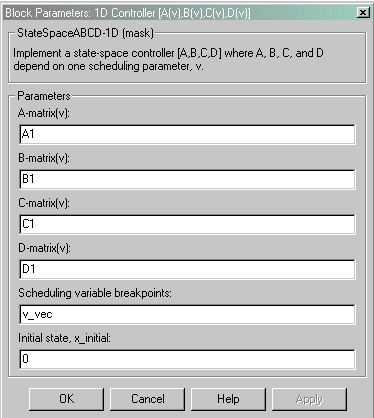| Aerospace Blockset |
  |
1D Controller [A(v),B(v),C(v),D(v)]
Purpose
Implement a gain-scheduled state-space controller depending on one scheduling parameter
Library
GNC
Description

The 1D Controller [A(v),B(v),C(v),D(v)] block implements a gain-scheduled state-space controller as defined by the equations
where v is a parameter over which A, B, C, and D are defined. This type of controller scheduling assumes that the matrices A, B, C, and D vary smoothly as a function of v, which is often the case in aerospace applications.
Dialog Box

- A-matrix(v)
- A-matrix of the state-space implementation. In the case of 1D scheduling, the A-matrix should have three dimensions, the last one corresponding to the scheduling variable v. Hence, for example, if the A-matrix corresponding to the first entry of v is the identity matrix, then A(:,:,1) = [1 0;0 1];.
- B-matrix(v)
- B-matrix of the state-space implementation. In the case of 1D scheduling, the B-matrix should have three dimensions, the last one corresponding to the scheduling variable v. Hence, for example, if the B-matrix corresponding to the first entry of v is the identity matrix, then B(:,:,1) = [1 0;0 1];.
- C-matrix(v)
- C-matrix of the state-space implementation. In the case of 1D scheduling, the C-matrix should have three dimensions, the last one corresponding to the scheduling variable v. Hence, for example, if the C-matrix corresponding to the first entry of v is the identity matrix, then C(:,:,1) = 1 0;0 1];.
- D-matrix(v)
- D-matrix of the state-space implementation. In the case of 1D scheduling, the D-matrix should have three dimensions, the last one corresponding to the scheduling variable v. Hence, for example, if the D-matrix corresponding to the first entry of v is the identity matrix, then D(:,:,1) = [1 0;0 1];.
- Scheduling variable breakpoints
- Vector of the breakpoints for the scheduling variable. The length of v should be same as the size of the third dimension of A, B, C, and D.
- Initial state, x_initial
- Vector of initial states for the controller, i.e., initial values for the state vector, x. It should have length equal to the size of the first dimension of A.
Inputs and Outputs
The first input is the measurements.
The second input is the scheduling variable conforming to the dimensions of the state-space matrices.
The output is the actuator demands.
Assumptions and Limitations
If the scheduling parameter input to the block goes out of range, then it is clipped; i.e., the state-space matrices are not interpolated out of range.
Examples
See the autopilot in the aeroblk_HL20.mdl demo for an example of this block.
See Also
1D Controller Blend u=(1-L).K1.y+L.K2.y
1D Observer Form [A(v),B(v),C(v),F(v),H(v)]
1D Self-Conditioned [A(v),B(v),C(v),D(v)]
2D Controller [A(v),B(v),C(v),D(v)]
3D Controller [A(v),B(v),C(v),D(v)]
 | Blocks -- Alphabetical List | | 1D Controller Blend u=(1-L).K1.y+L.K2.y |  |







